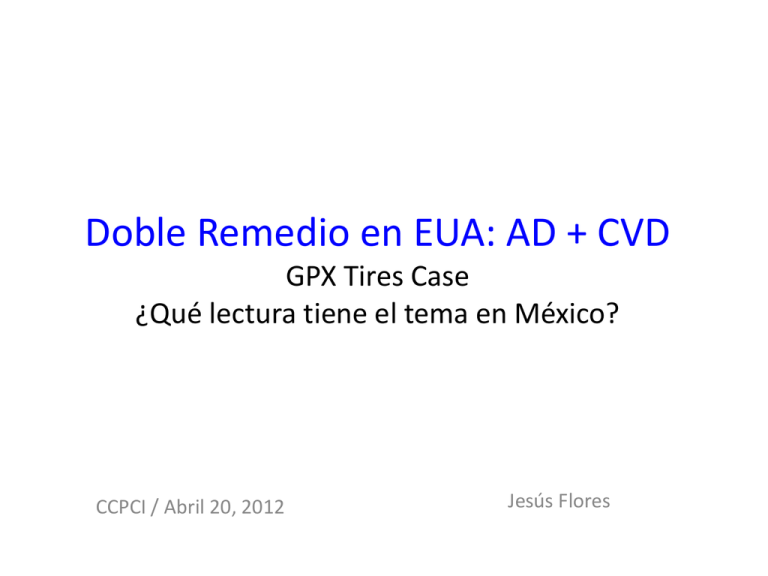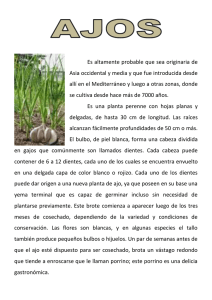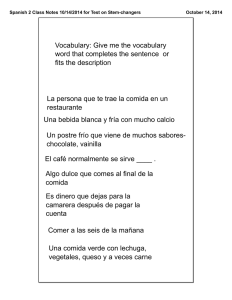Presentación de PowerPoint - www.ccpci.economia.gob.mx.
Anuncio

Doble Remedio en EUA: AD + CVD GPX Tires Case ¿Qué lectura tiene el tema en México? CCPCI / Abril 20, 2012 Jesús Flores AD + CVD: Lo que ha sucedido en EUA / ¿Qué procede? • Entre el 2005 y el 2010 hubo en Estados Unidos, Canadá y Europa una importante serie de casos AD + CVD en contra de las importaciones chinas (NME) • Esta serie de casos fue resultado del fracaso para convencer a China que detuviera el uso de subsidios para apoyar su producción y exportación • El impacto de estos casos fue muy relevante. Las importaciones se detuvieron drásticamente en los casos en que se resolvió aplicar AD + CVD • Estos casos fueron aplicados en diversas industrias como: Acero, química, manufacturas diversas. AD + CVD: Lo que ha sucedido en EUA / ¿Qué procede? • 2008: China apeló ante la OMC de que existía una doble contabilización del remedio. • En el 2010 la OMC resolvió en forma diversa, pero en síntesis no prospero. • Sin embargo en el 2011 en los Estados Unidos el tema se volvió judicial y una corte resolvio que EUA no podía aplicar AD + CVD • Finalmente el tema supero lo judicial y se volvió legislativo: A partir del 2012 el Congreso de EUA creo una nueva ley: AD + CVD es legal aplicarlo a un NME. AD + CVD: GPX / Leading case & La Corte de Apelaciones del CC • El «leading case» para resolver la controversia en el AD + CVD ha sido el GPX Tire case • Diciembre 19 del 2011 hizo pública la decisión de la Corte de Apelaciones para el Circuito de Columbia para el caso de las importaciones chinas de neumáticos GPX • La Corte había dicho que si bien no eran incompatibles ambos remedios, el DOC tenía que asegurarse que no hubiera una superposición entre las dos medidas. • La Corte de Apelaciones resolvió que bajo la legislación de Estados Unidos la provisión de fondos por un gobierno en un país Non Market Economy no puede constituir un subsidio compensable. • Es decir, en el caso de los países NME: sólo se puede imponer un derecho AD. • Esta decisión fue apelada por el Gobierno de USA ante la Corte Suprema de Justicia. Así surgen dos opciones: Confirmación ó decisión para no conocer el caso. • Posteriormente surgió una nueva alternativa para poder aplicar ambos remedios: Ley del Congreso de los Estados Unidos AD + CVD: S – 2153 & HR – 4105 • Marzo 5 y 6, 2012: Respectivamente; el Senado (S-2153) y Representantes (HR-4105) legislaron sobre AD & CVD. Ahora en Estados Unidos es legal aplicarlo a una NME. ¿Qué implicaciones hay para México? • Se propone al CCPCI este tema sea analizado y debatido y se establezcan las recomendaciones sobre el tema. Anexo AD + CVD: WTO China Appeal (1) • On 19 September 2008, China requested consultations concerning the definitive anti-dumping and countervailing duties imposed by the United States pursuant to the final anti-dumping and countervailing duty determinations and orders issued by the US Department of Commerce in several investigations. • China considers that these measures, which include the conduct of the underlying antidumping and countervailing duty investigations, are inconsistent with the obligations of the United States under, inter alia, Articles I and VI of the GATT 1994, Articles 1, 2, 10, 12, 13, 14, 19 and 32 of the SCM Agreement, Articles 1, 2, 6, 9 and 18 of the Anti-Dumping Agreement, and Article 15 of the Protocol on the Accession of the People's Republic of China (the Protocol of Accession). • On 9 December 2008, China requested the establishment of a panel. • 20 January 2009: the DSB established a panel. • Argentina, Australia, Bahrain, Canada, the European Communities, Kuwait, Saudi Arabia and Turkey reserved their third-party rights. Subsequently, Brazil, India, Japan, Mexico, Norway and Chinese Taipei reserved their third-party rights. On 23 February 2009, China requested the Director-General to determine the composition of the panel. On 4 March 2009, the Director-General composed the panel. AD + CVD: WTO China Appeal (2) • On 22 October 2010, the panel report was circulated to Members. In its report, the Panel addressed: • Countervailing duties and of anti-dumping duties calculated pursuant to the USDOC's non-market economy (“NME”) methodology resulted in the imposition of a “double remedy”, inconsistent with the United States' WTO obligations. • The Panel rejected China's claims challenging the USDOC's determinations that certain state-owned enterprises (“SOEs”) supplying inputs, and certain State-owned commercial banks (“SOCBs”) providing loans, to investigated producers were “public bodies” under Article 1.1 of the SCM Agreement. • The Panel rejected China's claims concerning the USDOC's rejection of in-country private prices in China as benchmarks to determine the existence and amount of benefit conferred by the government provision of inputs and of land-use rights in certain of the investigations at issue; • The Panel also rejected China's claims concerning the USDOC's rejection of interest rates in China as benchmarks AD + CVD: WTO China Appeal (3) • The Panel also upheld certain aspects of China's claim concerning the USDOC's calculation, in one of the investigations at issue, of the benefit conferred through the provision of inputs produced by SOEs but sold through private trading companies. • The Panel rejected China's claim regarding the USDOC's approach in the OTR investigation of not “offsetting” positive “benefit” amounts with negative “benefit” amounts, either across different kinds of rubber inputs or across different months of the period of investigation. • The Panel upheld China's claim against the USDOC's finding that government provision of certain land-use rights to one of the investigated producers was regionally specific under Article 2 of the SCM Agreement. AD + CVD: WTO China Appeal (4) • With respect to China's “double remedy” claims, the Panel agreed with the United States that the measure challenged as part of China's “as such” claims, as well as these claims themselves, fell outside its terms of reference since China failed to include that measure in its request for consultations. • The Panel rejected China's “as applied” claims with respect to double remedies — while it found that the use of an NME methodology in an AD investigation concurrently with the imposition of countervailing duties may give rise to “double remedies”, the Panel found that China had failed to establish the inconsistency of such a double remedy with the provisions of the SCM Agreement upon which China relied. . AD + CVD: GPX / Leading case • As discussed in greater detail below, Commerce ap-parently first considered whether to impose countervail-ing duties on goods from NME countries in 1983. • In 1983, Georgetown Steel Corp. and other American manufacturers petitioned Commerce to impose countervailing duties on imports from an NME (Czechoslovakia), and in 1984, Commerce determined that countervailing duty law did not apply to NMEs. • Carbon Steel Wire Rod from Czecho-slovakia: Final Negative Countervailing Duty Determination (“Wire Rod”), 49 Fed. Reg. 19,370, 19,370-19,371, 19,374 (May 7, 1984). • The American manufacturers appealed and succeeded in the Trade Court. Cont’l Steel Corp. v. United States, 614 F. Supp. 548 (Ct. Int’l Tr. 1985). • Commerce appealed to our court, arguing that a subsidy is “a device used by governments to distort the signals that the market gives to firms,” and that by definition, subsidies do not exist in NMEs. Brief for Appel-lant at 25, Georgetown Steel Corp. v. United States, 801 F.2d 1308 (Fed. Cir. 1986) (No. 85-2805) (“Georgetown Steel Brief”). AD + CVD: GPX / Leading case • • This court ultimately reinstated Commerce continued to maintain that countervailing duty law did not apply in a non-market context until 2007, when it issued a memorandum stating that it could apply countervailing duties to merchandise from China, an NME country. • Countervailing Duty Investigation of Coated Free Sheet Paper from the People’s Republic of China – Whether the Analytical Elements of the George-town Steel Opinion Are Applicable to China’s Present-Day Economy (Mar. 29, 2007), available at: • http://ia.ita.doc.gov/download/nme-sep-rates/prc-cfsp/china-cfs-georgetownapplicability.pdf (“Georgetown Steel Memo”). The George-town Steel Memo did not address the statutory text or legislative history of countervailing duty law; rather, it examined the details of China’s economy and determined that while China “remains an NME for purposes of the U.S. antidumping law,” it was “significantly different from the Soviet-style economies at issue in Georgetown Steel,”






